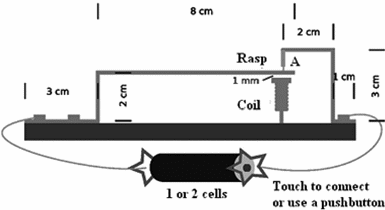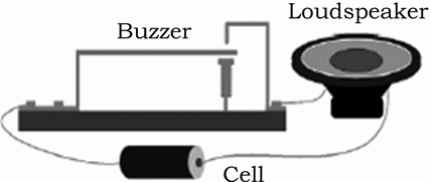Note: this article is part of my book Science Fair and Technology Education Experiments published in USA.
Figure 1 shows details of the construction of the buzzer. The same figure also shows the circuit to power the buzzer from a single cell.

Observe that the vibrating blade must touch point A in the figure, when the power is off. It is necessary to close the circuit in order to start the current that powers it.
The adjustment of the distance of these parts determines the correct operation of the buzzer and how loud is the sound.
How it Works
When the blades are in contact, the current can flow through the coil creating a strong magnetic field inside the nail. Then, the nail acts as a permanent magnet attracting the upside blade.
The attraction force is enough to bend the blade disconnecting and cutting off the current. Without current in the circuit, the magnetic field inside the nail disappears and the blade is not attracted any more. Returning to the initial position, the circuit closes and the process begins again.
The result of this is a fast open-close cycle that remains as long as the current is sourced to the circuit and causes the plate to vibrate producing sound. The mechanical characteristics of the blades and the attraction force of the coil will determine how loud the buzzer sounds.
The experiment
Adjust the blades to make contact with one another to make sure that the current can flow through the circuit. Connecting the cell, the blade will vibrate producing sound.
Adjust the upper blade to have the better sound. If the sound is very weak, try the use of two cells. Do not keep the circuit powered for long time intervals. The current drain is high and the cell will run down in a short time.
Suggestions:
By connecting a loudspeaker in series with the circuit, the sound can be amplified. The connection of a 3 ohm x 16 ohm loudspeaker is made as shown by figure 2.

Placing a manipulator (Morse Key), you can build a simple telegraph, sending messages in Morse code. Place the manipulator with a cell holder in one place and the buzzer far away, connected by long wires. The manipulator will be the transmitter station and the buzzer, the receiver.
Building two circuits like this you can have a complete transmitter-receiver telegraph station. A good work for demonstrations in a Science Fair. See our telecommunication projects.
Competition
The challenge is to see who can build the buzzer that produces the loudest sound.
Questions
1. Just by connecting directly the cell to the coil, why doesn’t the circuit produce vibrations?
2. Explain how a domestic door-bell functions.
3. Find on the Internet the Morse code and explain how to use it in the telegraph application for the buzzer.
5 to 10 meters of enameled wire 30 to 34 AWG
1 small nail—3 to 4 cm long
1 wood base—1.5 x 5 x 12 cm
2 pieces of tin cut as shown by figure 20.
4 small nails—1 cm long
1 AA, C or D cell
Wires, tools, glue, etc.



